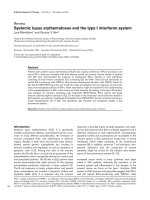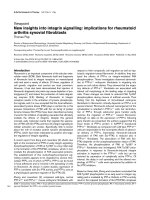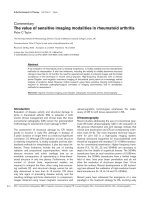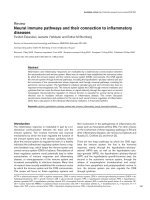Báo cáo y học: "Anti-Sa antibodies: prognostic and pathogenetic significance to rheumatoid arthritis" doc
Bạn đang xem bản rút gọn của tài liệu. Xem và tải ngay bản đầy đủ của tài liệu tại đây (47.54 KB, 4 trang )
86
AFA = anti-filaggrin antibodies; AKA = anti-keratin antibodies; CCP = cyclical citrullinated peptide; G6PI = glucose-6-phosphate isomerase; PAD =
peptidyl arginine deaminase; RA = rheumatoid arthritis; RF = rheumatoid factor.
Arthritis Research & Therapy Vol 6 No 2 El-Gabalawy and Wilkins
Rheumatoid arthritis (RA) is characterized by the develop-
ment of a persistent, destructive synovitis that targets
multiple joints. The joint involvement is often additive over
time, and there is an intriguing propensity for symmetry in
the way that the joints are affected. The other characteristic
feature of this disease is the presence of specific
autoantibodies in the sera of most RA patients. Although
this has been the strongest line of evidence suggesting
that RA is an autoimmune disease, it has proved to be a
major challenge to understand how the synovitis and the
autoantibody production are related pathogenetically, and
whether one is dependent on the other. The study
published in the current issue of Arthritis Research and
Therapy identifying the antigen against which the RA
associated anti-Sa antibodies are directed brings us
closer to this understanding [1].
Epidemiology of anti-Sa antibodies
Anti-Sa antibodies were originally identified in a French
Canadian patient with RA, and this reactivity was found to
be highly specific for RA [2]. Subsequent studies have
confirmed the high degree of RA specificity, which
exceeds 95% in several populations tested [3–6]. The
sensitivity of this antibody for RA varies with the stage of
the disease tested, ranging from a low of 20–25% in early
RA cohorts [5,6] to a high of 47% in patients with more
established disease [6].
An association between anti-Sa antibodies and disease
severity has also been demonstrated. In an early RA
cohort, the anti-Sa-positive subset had a high mean joint
count, a high prevalence of early erosions, and a require-
ment for more aggressive therapy (Table 1) [5]. Interestingly,
most of the anti-Sa-positive patients in this cohort were
males, a finding that has not been reported in other RA
cohorts. The propensity towards progressive erosions in
anti-Sa-positive patients was recently confirmed in another
early polyarthritis cohort [7]. A study of patients with
established RA showed that patients with destructive
disease were three times more likely to be anti-Sa positive
than patients without destructive disease [6]. Together
these data indicate that anti-Sa antibodies are present
early in the disease and are markers of an aggressive,
destructive form of RA synovitis.
Commentary
Anti-Sa antibodies: prognostic and pathogenetic significance to
rheumatoid arthritis
Hani S El-Gabalawy and John A Wilkins
Rheumatic Disease Research Laboratory, University of Manitoba, Winnipeg, Manitoba, Canada
Corresponding author: Hani El-Gabalawy (e-mail: )
Received: 22 Feb 2004 Accepted: 5 Mar 2004 Published: 10 Mar 2004
Arthritis Res Ther 2004, 6:86-89 (DOI 10.1186/ar1171)
© 2004 BioMed Central Ltd (Print ISSN 1478-6354; Online ISSN 1478-6362)
See related Research article: />Abstract
Anti-Sa antibodies are detected in the serum of 20–47% of patients with rheumatoid arthritis. These
antibodies have a high degree of specificity for the disease, and appear to identify a subset of early
rheumatoid arthritis patients destined to have aggressive and destructive disease. It has recently been
confirmed that anti-Sa antibodies are directed to citrullinated vimentin, thus placing them in the anti-
citrulline family of autoantibodies. The Sa antigen has previously been shown to be present in synovium.
This, along with the demonstration of citrullinated proteins in rheumatoid synovium, suggests that anti-Sa
antibodies may play a pathogenetic role in the initiation and/or persistence of rheumatoid synovitis.
Keywords: anti-citrulline antibodies, anti-Sa, autoantibodies, prognosis, rheumatoid arthritis, synovium
87
Available online />Serum reactivity to Sa overlaps considerably but
incompletely with anti-cyclical citrullinated peptide (anti-
CCP), anti-filaggrin antibodies (AFA), and anti-keratin
antibodies (AKA). Data from one early synovitis cohort
demonstrated that 23% of the anti-Sa-positive patients
were not positive for these other autoantibodies [5].
Similarly, 27% of AFA-positive patients were not
recognized by any other assay. It should be noted that the
currently available anti-CCP enzyme-linked immunosorbent
assay is more sensitive than the original assay used in this
study, and it is possible that some of these anti-Sa-positive
and AFA-positive patients would be detected by the more
sensitive assay. Nevertheless, these data are consistent
with the heterogeneity demonstrated in RA sera when
tested against a spectrum of citrullinated peptides [8].
Anti-Sa antibodies are directed toward
citrullinated vimentin
A body of research has clearly established that the sera of
most RA patients have antibodies directed against
antigens containing the non-standard amino acid citrulline
(reviewed in [9]). Citrulline is generated by the post-
translational deimination of arginine residues by peptidyl
arginine deiminases (PADs), a family of enzymes whose
members have a tissue-specific distribution. Several
previously described RA-specific autoantibodies including
AKA, AFA, and anti-perinuclear factor have been shown to
recognize citrullinated antigens [8]. This has led to the
hypothesis that immune responses to endogenous
citrullinated antigens are unique to RA and are potentially
of pathogenetic significance in this disease.
Although it has been speculated the anti-Sa antibodies
might be directed towards a citrullinated antigen, this has
not been directly confirmed until now [1]. The results of
the Vossenaar paper identify citrullinated forms of vimentin
as the major antigen recognized by sera containing anti-Sa
reactivity. However, it is apparent from the immunoblotting
studies presented that the patterns of reactivity of anti-
citrulline and anti-Sa are overlapping but not identical,
suggesting that additional reactivity might be present in
the anti-Sa-positive sera. Vimentin was identified on the
basis of microsequences of two peptides, one which was
specific to vimentin (residues 72–86) and the other
(residues 283–293) was present in both vimentin and a
related neural intermediate filament component, peripherin
[10]. Because of the polyclonal nature of the autoimmune
sera, and the relative differences in the detection
sensitivities of the Western blot and microsequencing, it
will be important to demonstrate clearly that vimentin is
indeed the only antigen detected in this molecular mass
region by sera containing anti-Sa reactivity. It is also
important to consider that in cases where post-trans-
lational modifications are a component of the autoantigen,
the most readily detectable target might not necessarily
reflect the biologically relevant antigen, but rather the most
abundant species with the given post-translational modifi-
cation. Thus, although a citrullinated form of vimentin is
clearly a major autoantigen recognized by anti-Sa-positive
sera, other autoantigens might also be recognized.
Citrullinated autoantigens in RA synovitis
If antibodies against citrullinated antigens do have a role in
the pathogenesis of RA synovitis, these antibodies and the
antigens they recognize should be present in the
synovium. In keeping with this, it has been shown that anti-
citrulline antibodies are indeed produced locally in RA
synovium by B lymphocytes and plasma cells [11,12], and
that these antibodies represent a much larger proportion
of the total IgG content of the synovium than of matched
peripheral blood [12]. Moreover, rheumatoid factor (RF)
synovial tissue explants continue to produce AFA for
prolonged periods in culture.
The presence of locally produced anti-citrulline antibodies
suggests that one or more synovial antigens stimulate
their production. Detailed studies of the synovium of AFA-
positive RA patients demonstrated that these antibodies
uniquely recognize citrullinated forms of fibrin and
fibrinogen in RA synovium [13]. From a pathogenetic
viewpoint, this autoantigen would seem more likely to be
relevant to RA than filaggrin, which is found in the
epidermis and not the synovium. Interestingly, both share
the property of being composed of repeating units
capable of varying degrees of citrullination. It is of
relevance that we have demonstrated, in a histopathologic
study of synovium derived from patients with early
synovitis, a strong association between the presence of
stromal fibrin deposits and the presence of anti-citrulline
antibodies in patient sera [14].
Table 1
Anti-Sa-positive patients with early rheumatoid arthritis have
more severe disease
Sa
+
RA Sa
–
RA
Parameter (n = 23) (n = 83)
Rheumatoid factor positive (%) 83 61
Males (%) 61
*
17
Swollen joint count 18 ± 12
*
13 ± 9
C-reactive protein (mg/dl) 2.6 ± 3
*
1.6 ± 1.4
Erosions (%) 60
*
33
No. of DMARDs used 1.4 ± 0.8
*
0.9 ± 0.7
Prednisone (mg/d) 4.8 ± 6.0
*
1.8 ± 3.3
Inactive disease (%) 0 12
*
P < 0.05 compared with anti-Sa-negative rheumatoid arthritis.
DMARD, disease-modifying anti-rheumatic drug; RA, rheumatoid
arthritis; RF, rheumatoid factor. Errors are shown as standard
deviations. Data from [5].
88
Arthritis Research & Therapy Vol 6 No 2 El-Gabalawy and Wilkins
Citrullinated vimentin is an appealing possibility as a
synovial autoantigen in RA. The Sa antigen, which is
derived from placental tissue and is used to detect anti-Sa
antibodies by immunoblotting, was originally shown to be
present in synovium [2]. Vimentin is an intermediate
filament that is widely expressed in mesenchymal cells and
macrophages, and is readily detectable in synovium and
fibroblast-like synoviocytes [15–17]. The current data
suggest that for synovial vimentin to serve as an
autoantigen for anti-Sa antibodies, this protein needs to
be citrullinated in the synovial microenvironment. In vivo,
vimentin is usually not in a citrullinated state, and
deimination of this protein by PAD is required for the
generation of a suitable antigen that would be recognized
by anti-Sa antibodies [18]. Although PAD2 and PAD4 are
widely expressed in synovium, they seem to require high
intracellular calcium concentrations to deiminate
cytoplasmic proteins such as vimentin, and the typically
low cytoplasmic concentrations of calcium would not
allow this to occur [18,19]. Deimination of vimentin by
PAD probably occurs in macrophages when they undergo
apoptosis, a process that results in an influx of calcium
into the cell [18]. On the basis of this, it is proposed that
citrullinated vimentin is most probably generated in the RA
synovial microenvironment when macrophages and other
cells undergo apoptosis. Yet the generally low apoptotic
indices found in RA synovitis would suggest that this
process occurs at a relatively low rate (reviewed in [20]).
In contrast, inadequate clearance of apoptotic material
might lead to persistence of the modified vimentin and
might in turn promote the development of anti-Sa
antibodies. Because it seems, on the basis of the
epidemiologic data, that the anti-Sa-positive patients with
RA have particularly severe, destructive disease, synovial
expression of the Sa antigen needs to be studied
systematically in detailed immunohistologic studies.
Do autoantibodies against citrullinated
antigens initiate and/or perpetuate RA?
The serum transfer model of Benoist and Mathis has
shown that antibodies against the ubiquitous enzyme
glucose-6-phosphate isomerase (G6PI) can induce a
destructive, RA-like arthropathy in mice from a wide
spectrum of genetic backgrounds [21]. The mechanisms
by which the synovitis and articular damage occur are still
under exploration, but an important role for components of
the innate immune system, such as mast cells, has been
demonstrated [22]. The relevance of anti-G6PI antibodies
in human RA has been debated. Although one study
suggested that anti-G6PI antibodies are uniquely present
in RA patients [23], these findings have not been
confirmed in several other patient cohorts [24].
Notwithstanding this debate, the serum transfer model
does indicate that an antibody directed against a
ubiquitous antigen can directly precipitate a destructive
inflammatory process that specifically targets the joints.
It has been demonstrated that both RF and anti-CCP
antibodies are present in the sera of at least some RA
patients years before the onset of clinical disease [25].
Data about anti-Sa reactivity in such patients is currently
unavailable. The titers of anti-CCP antibodies in these
‘preclinical’ individuals seem to increase progressively
until disease onset. Presumably these responses are
sustained by low-level antigenic stimulation until such a
point at which a clinical threshold is crossed, and overt
synovitis is precipitated. Exposure to new citrullinated
synovial antigens expressed during inflammatory ‘flares’,
when apoptotic indices are probably at their highest,
would then further stimulate and mature these responses
and, importantly, localize them to lymphoid structures in
the synovial membrane on a chronic basis.
The spectrum of autoantigens that participate in, and
sustain, RA synovitis continues to be explored. Proteomic
approaches can be expected to have a significant role in
the characterization of these autoantigens. With the use of
combined Western blot and in-gel digestion approaches,
candidate antigens have been identified in Behcet’s
disease [26] and anterior uveitis [27]. By using affinity-
purified autoantibodies against post-translationally modified
proteins, it should be feasible to capture a spectrum of
antigens expressing a given modification. This should
provide a better understanding of the repertoire of
potential target antigens and their possible roles in the
pathogenic process.
Competing interests
None declared.
References
1. Vossenaar ER, Deprés N, Lapointe E, van der Heijden A, Lora M,
Senshu T, van Venrooij WJ, Ménard HA: Rheumatoid arthritis
specific anti-Sa antibodies target citrullinated vimentin. Arthri-
tis Res Ther 2004, 6:R142-R150.
2. Despres N, Boire G, Lopez-Longo FJ, Menard HA: The Sa
system: a novel antigen–antibody system specific for rheuma-
toid arthritis. J Rheumatol 1994, 21:1027-1033.
3. Escalona M, Lopez-Longo FJ, Gonzalez CM, Monteagudo I,
Rodriguez-Mahou M, Grau R, Carreno L: Anti-Sa sera from
patients with rheumatoid arthritis contain at least 2 different
subpopulations of anti-Sa antibodies. J Rheumatol 2002, 29:
2053-2060.
4. Hueber W, Hassfeld W, Smolen JS, Steiner G: Sensitivity and
specificity of anti-Sa autoantibodies for rheumatoid arthritis.
Rheumatology (Oxford) 1999, 38:155-159.
5. Goldbach-Mansky R, Lee J, McCoy A, Hoxworth J, Yarboro C,
Smolen JS, Steiner G, Rosen A, Zhang C, Menard HA, Zhou ZJ,
Palosuo T, Van Venrooij WJ, Wilder RL, Klippel JH, Schumacher
HR Jr, El-Gabalawy HS: Rheumatoid arthritis associated
autoantibodies in patients with synovitis of recent onset.
Arthritis Res 2000, 2:236-243.
6. Hayem G, Chazerain P, Combe B, Elias A, Haim T, Nicaise P,
Benali K, Eliaou JF, Kahn MF, Sany J, Meyer O: Anti-Sa antibody
is an accurate diagnostic and prognostic marker in adult
rheumatoid arthritis. J Rheumatol 1999, 26:7-13.
7. Boire G, Cossette P, de Brum-Fernandes AJ, Liang P, Nyonsenga
T, Gingras M, Daniel C, Beauchemin J, Ménard HA: Anti-Sa/cit-
rullinated vimentin antibodies, anti-cyclic citrullinated peptide,
and IgM rheumatoid factor (RF) as prognostic markers of
disease severity in early polyarthritis patients [abstract].
Arthritis Rheum 2003, 48 Suppl:S666.
89
8. Schellekens GA, de Jong BA, van den Hoogen FH, van de Putte
LB, van Venrooij WJ: Citrulline is an essential constituent of
antigenic determinants recognized by rheumatoid arthritis-
specific autoantibodies. J Clin Invest 1998, 101:273-281.
9. Vossenaar ER, van Venrooij WJ: Anti-CCP antibodies, a specific
marker for (early) rheumatoid arthritis. Clin Applied Immunol
Rev 2004, in press.
10. Foley J, Ley CA, Parysek LM: The structure of the human
peripherin gene (PRPH) and identification of potential regula-
tory elements. Genomics 1994, 22:456-461.
11. Reparon-Schuijt CC, van Esch WJ, van Kooten C, Schellekens GA,
de Jong BA, van Venrooij WJ, Breedveld FC, Verweij CL: Secretion
of anti-citrulline-containing peptide antibody by B lymphocytes
in rheumatoid arthritis. Arthritis Rheum 2001, 44:41-47.
12. Masson-Bessiere C, Sebbag M, Durieux JJ, Nogueira L, Vincent
C, Girbal-Neuhauser E, Durroux R, Cantagrel A, Serre G: In the
rheumatoid pannus, anti-filaggrin autoantibodies are pro-
duced by local plasma cells and constitute a higher propor-
tion of IgG than in synovial fluid and serum. Clin Exp Immunol
2000, 119:544-552.
13. Masson-Bessiere C, Sebbag M, Girbal-Neuhauser E, Nogueira L,
Vincent C, Senshu T, Serre G: The major synovial targets of the
rheumatoid arthritis-specific antifilaggrin autoantibodies are
deiminated forms of the alpha- and beta-chains of fibrin. J
Immunol 2001, 166:4177-4184.
14. El-Gabalawy HS, Hitchon CA, Schumacher HR, Yarboro C, Duray
P, Goldbach-Mansky R: Synovial histopathological features and
RA autoantibodies predict persistence in patients with synovitis
of recent onset [abstract]. Arthritis Rheum 2003, 48 Suppl:S667.
15. Ota F, Maeshima A, Yamashita S, Ikeuchi H, Kaneko Y, Kuroiwa T,
Hiromura K, Ueki K, Kojima I, Nojima Y: Activin A induces cell
proliferation of fibroblast-like synoviocytes in rheumatoid
arthritis. Arthritis Rheum 2003, 48:2442-2449.
16. Marinova-Mutafchieva L, Taylor P, Funa K, Maini RN, Zvaifler NJ:
Mesenchymal cells expressing bone morphogenetic protein
receptors are present in the rheumatoid arthritis joint. Arthritis
Rheum 2000, 43:2046-2055.
17. Xue C, Takahashi M, Hasunuma T, Aono H, Yamamoto K, Yoshino
S, Sumida T, Nishioka K: Characterisation of fibroblast-like
cells in pannus lesions of patients with rheumatoid arthritis
sharing properties of fibroblasts and chondrocytes. Ann
Rheum Dis 1997, 56:262-267.
18. Vossenaar ER, Radstake TR, van der Heijden A, Van Mansum
WAM, Dieteren C, de Rooij DJ, Barrera P, Zendman AJW, van Ven-
rooij WJ: Expression and activity of citrullinating PAD enzymes
in monocytes and macrophages. Ann Rheum Dis 2004, in press.
19. Inagaki M, Takahara H, Nishi Y, Sugawara K, Sato C: Ca
2+
-
dependent deimination-induced disassembly of intermediate
filaments involves specific modification of the amino-terminal
head domain. J Biol Chem 1989, 264:18119-18127.
20. Baier A, Meineckel I, Gay S, Pap T: Apoptosis in rheumatoid
arthritis. Curr Opin Rheumatol 2003, 15:274-279.
21. Matsumoto I, Staub A, Benoist C, Mathis D: Arthritis provoked
by linked T and B cell recognition of a glycolytic enzyme.
Science 1999, 286:1732-1735.
22. Lee DM, Friend DS, Gurish MF, Benoist C, Mathis D, Brenner
MB: Mast cells: a cellular link between autoantibodies and
inflammatory arthritis. Science 2002, 297:1689-1692.
23. Schaller M, Burton DR, Ditzel HJ: Autoantibodies to GPI in
rheumatoid arthritis: linkage between an animal model and
human disease. Nat Immunol 2001, 2:746-753.
24. Matsumoto I, Lee DM, Goldbach-Mansky R, Sumida T, Hitchon
CA, Schur PH, Anderson RJ, Coblyn JS, Weinblatt ME, Brenner
M, Duclos B, Pasquali JL, El Gabalawy H, Mathis D, Benoist C:
Low prevalence of antibodies to glucose-6-phosphate iso-
merase in patients with rheumatoid arthritis and a spectrum
of other chronic autoimmune disorders. Arthritis Rheum 2003,
48:944-954.
25. Rantapaa-Dahlqvist S, de Jong BA, Berglin E, Hallmans G, Wadell
G, Stenlund H, Sundin U, van Venrooij WJ: Antibodies against
cyclic citrullinated peptide and IgA rheumatoid factor predict
the development of rheumatoid arthritis. Arthritis Rheum 2003,
48:2741-2749.
26. Lee KH, Chung HS, Kim HS, Oh SH, Ha MK, Baik JH, Lee S,
Bang D: Human alpha-enolase from endothelial cells as a
target antigen of anti-endothelial cell antibody in Behcet’s
disease. Arthritis Rheum 2003, 48:2025-2035.
27. Stempel D, Sandusky H, Lampi K, Cilluffo M, Horwitz J, Braun J,
Goodglick L, Gordon LK:
ββ
B1-crystallin: identification of a can-
didate ciliary body uveitis antigen. Invest Ophthalmol Vis Sci
2003, 44:203-209.
Correspondence
Hani El-Gabalawy MD, Room 805, John Buhler Research Centre,
715 McDermot Avenue, Winnipeg, Manitoba, Canada R3E 3P4.
Tel: +1 204 787 2209; fax: +1 204 787 2475; e-mail:
Available online />








